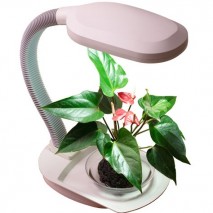
All plants require light to survive. It provides the energy they need to convert water (taken in through the roots) and carbon dioxide (absorbed by the leaves) into the carbohydrates that make up the structure of a plant. This process is called photosynthesis, which means “assembly by light”.
The conditions inside buildings are very different from those in nature so interior landscapers need to understand how different plants use light and how they adapt to life indoors.
Light sources
The light that indoor plants receive comes from many different sources. Both daylight and light from artificial sources are used by the plant for photosynthesis. Natural daylight, if available in sufficient intensity and duration, is the cheapest and best. However, the amount of sunlight getting through to the inside of a building can be surprisingly low. Outside on a bright, sunny day there may be 50,000 lux (1 lux = 0.093 foot candles), but the absorbing or blocking effects of glass, blinds, furniture, walls and the shading from surrounding buildings can reduce this to a few hundred lux inside a room.
For interior landscapes, artificial light often needs to be provided as a substitute or supplement for natural light. From a plant’s point of view, the quality of the artificial light depends on the type of lamp providing it. There are three main types of artificial light used in buildings, incandescent, fluorescent and gas discharge. They are described below.
Incandescent lighting
Incandescent, “filament” type lighting is generally unsuitable for photosynthesis because they produce light high in the orange/red bands, which may cause excessive elongation of the plants. Some tungsten lamps are given a blue filter and called “plant lights” but these tend to be short lived and uneconomic to run as a principal source of illumination. However, when used in spots and/or pendant luminaires they can be useful in providing accent lighting on flower or plant displays.
Halogen lighting
Halogen lights are a type of incandescent lamp that are increasingly popular in buildings. They are small but produce a lot of light and they are often mounted as spot lights. The quality of light produced is satisfactory for plant growth, and there are some very nice ‘plant lights’ sold as an accessory for indoor plant displays. There are, however, two disadvantages that must be considered.
First, many halogen spotlights are focused on a small area, so if they are to be used for plants, it is essential that correct light measurements are made. Illumination levels drop off rapidly away from the centre of illumination.
Secondly, the bulbs get very hot. They should not be placed too close to the leaves of a plant, otherwise the they will be scorched. A distance of at least 50 cm is recommended.
Fluorescent lighting
Fluorescent lighting is probably the most common in offices, restaurants and other commercial buildings. Most are designed for a maximum output in the 550nm band (green/yellow) and are therefore not ideally suited to plant growth, as the 440nm and 660nm bands are deficient. However, some specialist fluorescent tubes reproduce a much fuller spectrum and are becoming more popular in offices where they have been shown to benefit people as well as plants. Compact fluorescent luminaires that replace standard incandescent light bulbs are becoming increasingly popular as they are economical to use and relatively inexpensive to buy. Some compact fluorescent luminaires are also available with near daylight quality.
Plant light requirements
Whatever the light source, a plant’s first “instinct” when installed in a building is to orientate its leaves towards the strongest light source. This is most easily observed near a bright window, where the leaves will turn rapidly to face the sun. However an interior plant’s long-term chances of survival depend on its ability to adapt to low light levels. It may do this in several ways.
- By rearranging the light-trapping chloroplasts so that they are all on the upper surface of the leaf. This ensures that they are facing the light rather than being randomly distributed throughout the leaf.
- By losing leaf variegation, e.g. in species such as Hedera helix, Epipremnum aureum and Ficus benjamina. The increased amount of chlorophyll in the previously unpigmented parts of the leaf helps to trap more light.
- By stretching new growth towards the light. The spindly stems and small leaves of Ficus benjamina under low light are a good example of this.
- By dropping leaves, so that a smaller “area” of plant is competing for the available light. To get the best out of a plant it is therefore important to know the light levels available and to choose species accordingly.


